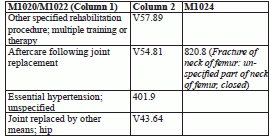Home Health ICD-9/ICD-10 Alert
Look to M1024 for Possible Risk Adjustment
Question: Our new patient was admitted after four weeks of rehab following a hip replacement due to a fracture after a fall at home. We will be providing physical therapy for gait training, transfer training, and strengthening. Occupational therapy will provide activities of daily living training. The patient has hypertension which is controlled with medication. How should we code for this patient?
Colorado Subscriber
Answer: List the following codes for this patient:

When therapy is the only service you’re providing, the Official Coding Guidelines require that a code from the V57.x (Care involving use of rehabilitation procedures) series is listed as the principal diagnosis code to show the admission is for rehabilitation. This is true even when you’re caring for a patient with a fracture.
Tip: If you’ll be providing multiple therapies, as in this scenario, the correct code to list is V57.89 (Other specified rehabilitation procedure; multiple training or therapy).
Following the V57.x code, you’ll need to report a code to describe the condition being treated. In your patient’s case, list V54.81 to indicate that therapy is providing aftercare for this patient’s joint replacement. In situations like this, list V54.81, rather than a fracture aftercare code, because the patient’s fracture has been treated with the joint replacement and the fracture is no longer present.
Pair the joint replacement aftercare code with 820.8 in M1024 to indicate that a V code (V54.81) replaces a case mix diagnosis code in M1022. Codes V57.89 and V54.81 do not make the fracture code eligible for case mix points (only V54.1 and V54.2 will send the grouper to look for fracture points). However, if a V code replaces a resolved case mix diagnosis that’s relevant to the plan of care, you can report this code in M1024 for potential risk adjustment, but it will not be awarded case mix points. In this case, the underlying cause for the surgery, the hip fracture (820.8), is case mix so you can report it in M1024.
Note: This situation may not earn you risk adjustment on your outcomes if the fracture was already coded in M1010 or M1016.
If the documentation includes details about how the patient’s hypertension will impact the care you provide, you’ll list 401.9 next.
Finally, list V43.64 to specify the location of your patient’s joint replacement.
Home Health ICD-9/ICD-10 Alert
- Conquering Case Mix:
Increase Your Focus on Accurate Coding as CMS Cuts 170 Case Mix Codes
Your coding and OASIS accuracy are more important than ever. It’s official: CMS will slash [...] - Examine Your Claims for These Commonly Used Deleted Codes
In Table 3 of the final rule, CMS lists the deleted codes most used in [...] - ICD-10:
Look for Familiar Guidelines for ICD-10 Hypertension Coding
You’ll still need physician documentation for hypertensive heart disease. You’ll be happy to know that [...] - You Be the Coder:
Know when to Assume with Hypertension in ICD-10
Question: Your patient was referred to home health for skilled nursing to assess and instruct [...] - Medical Review:
Prevent Hypertension Denials or Pay the Price
An internal audit can help prevent future denials. Your hypertension claims are under fire. But [...] - Add Tobacco Use Codes with HTN in ICD-10
When coding for hypertension in ICD-10, no matter which category you select, you are instructed [...] - Coding Quiz:
Try Coding this Diabetic Triopathy
Are you ready for an ICD-10 coding workout? The three most common diabetic manifestations, also [...] - Reader Question:
Look to M1024 for Possible Risk Adjustment
Question: Our new patient was admitted after four weeks of rehab following a hip replacement [...]

